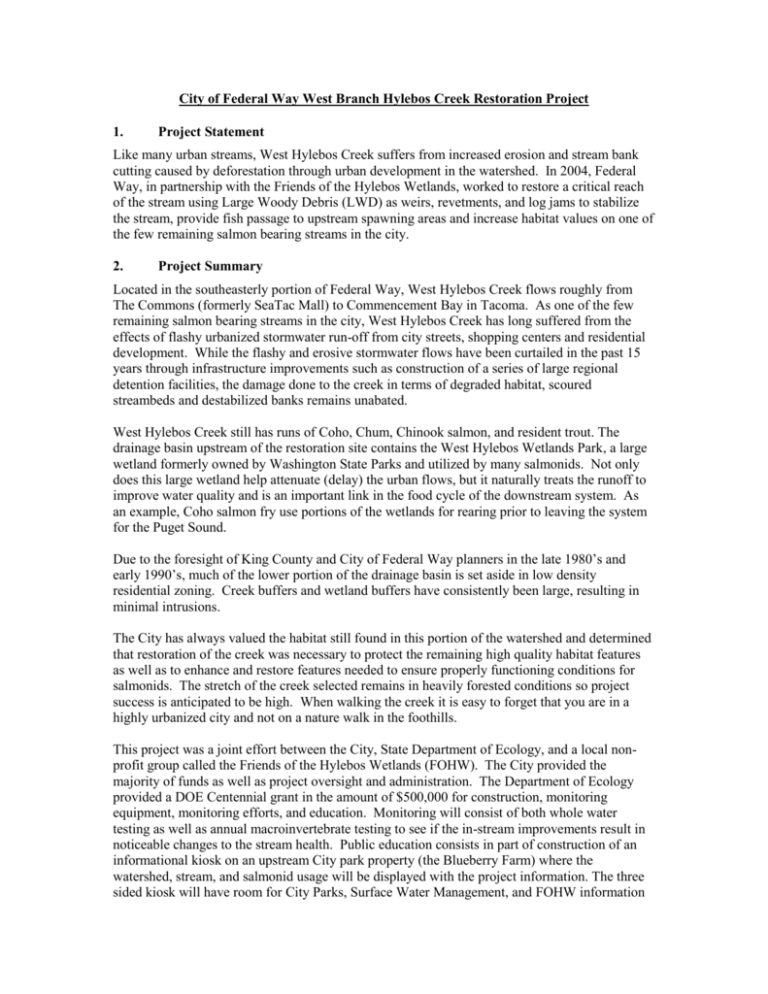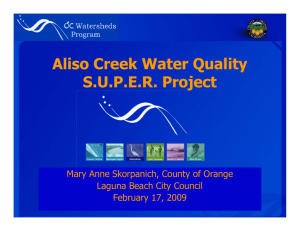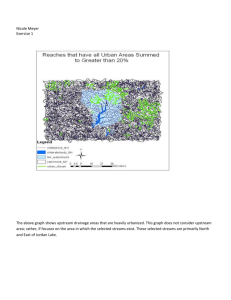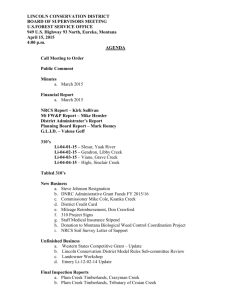City of Federal Way West Branch Hylebos Creek Restoration Project
advertisement

City of Federal Way West Branch Hylebos Creek Restoration Project 1. Project Statement Like many urban streams, West Hylebos Creek suffers from increased erosion and stream bank cutting caused by deforestation through urban development in the watershed. In 2004, Federal Way, in partnership with the Friends of the Hylebos Wetlands, worked to restore a critical reach of the stream using Large Woody Debris (LWD) as weirs, revetments, and log jams to stabilize the stream, provide fish passage to upstream spawning areas and increase habitat values on one of the few remaining salmon bearing streams in the city. 2. Project Summary Located in the southeasterly portion of Federal Way, West Hylebos Creek flows roughly from The Commons (formerly SeaTac Mall) to Commencement Bay in Tacoma. As one of the few remaining salmon bearing streams in the city, West Hylebos Creek has long suffered from the effects of flashy urbanized stormwater run-off from city streets, shopping centers and residential development. While the flashy and erosive stormwater flows have been curtailed in the past 15 years through infrastructure improvements such as construction of a series of large regional detention facilities, the damage done to the creek in terms of degraded habitat, scoured streambeds and destabilized banks remains unabated. West Hylebos Creek still has runs of Coho, Chum, Chinook salmon, and resident trout. The drainage basin upstream of the restoration site contains the West Hylebos Wetlands Park, a large wetland formerly owned by Washington State Parks and utilized by many salmonids. Not only does this large wetland help attenuate (delay) the urban flows, but it naturally treats the runoff to improve water quality and is an important link in the food cycle of the downstream system. As an example, Coho salmon fry use portions of the wetlands for rearing prior to leaving the system for the Puget Sound. Due to the foresight of King County and City of Federal Way planners in the late 1980’s and early 1990’s, much of the lower portion of the drainage basin is set aside in low density residential zoning. Creek buffers and wetland buffers have consistently been large, resulting in minimal intrusions. The City has always valued the habitat still found in this portion of the watershed and determined that restoration of the creek was necessary to protect the remaining high quality habitat features as well as to enhance and restore features needed to ensure properly functioning conditions for salmonids. The stretch of the creek selected remains in heavily forested conditions so project success is anticipated to be high. When walking the creek it is easy to forget that you are in a highly urbanized city and not on a nature walk in the foothills. This project was a joint effort between the City, State Department of Ecology, and a local nonprofit group called the Friends of the Hylebos Wetlands (FOHW). The City provided the majority of funds as well as project oversight and administration. The Department of Ecology provided a DOE Centennial grant in the amount of $500,000 for construction, monitoring equipment, monitoring efforts, and education. Monitoring will consist of both whole water testing as well as annual macroinvertebrate testing to see if the in-stream improvements result in noticeable changes to the stream health. Public education consists in part of construction of an informational kiosk on an upstream City park property (the Blueberry Farm) where the watershed, stream, and salmonid usage will be displayed with the project information. The three sided kiosk will have room for City Parks, Surface Water Management, and FOHW information Municipal Achievement Awards 2005 West Hylebos Creek Restoration Project City of Federal Way Page 2 on Hylebos Creek and its drainage basin. Each organization brings a different perspective to the system and habitat features that combined present a holistic perspective of the creek system. FOHW was a major supporter of the project through letters, appearances, and citizen contacts. The FOHW obtained a $50,000 National Oceanic and Atmospheric Administration (NOAA) grant for the City which is expected to be used for additional restoration upstream of the project. Perhaps the most valuable contribution was their efforts to build relationships with homeowners and garner support for the project. Some of the local residents have been suspicious of government in general and FOHW was able to approach them where the city may have had more difficulty. What is the Project? The project consists of restoring approximately 2,300 lineal feet of the West Branch of Hylebos Creek between SR-99 at a Montessori School upstream to approximately 2,000 feet south of S. 356th Street. A primary task for the project team was to determine a way to stop the incision of the creek channel and stabilize the materials in place. During large events, tons of stream bed rock move out of the system and deposit ¼ mile downstream in a low gradient stretch of the creek. This has historically resulted in large scale flooding of property and a city road, S. 373rd. Previously, the answer to this deposition was to dredge the creek at the road crossing during the summer. The city only used this as a last measure when all else failed and recognized that this was not in the best interest of the environment. This stretch of creek contains the most valuable spawning ground in the system, so the city was interested in finding a solution to the on-going problem. During the investigation of the restoration site, the consultant team discovered that approximately 600 feet of the stream was located in a stretch of historically unstable high banks with evidence of landslides, both old as well as active. Further, most of the creek was located in a well forested area with limited access for construction equipment. Landslides from ravine slopes, channel down-cutting, large gravel bars in the channel and eroding stream banks were all challenges to be overcome with this project. The final design called for constructing log jams within the creek system through the use of a helicopter to bring in the materials. The jams consist of criss-crossing and over/under logs that were jockeyed into place by brute force, large truck jacks, chains, and a deep understanding of the principles of leverage. Due to the heavy over-story of branches, many of the logs were laid a bit haphazardly in position by the helicopter crew which was delivering logs at the rate on one every three minutes. This resulted in the contractor having to spend one to three days on each structure moving the logs into place and pinning them together. There were two sites accessible by vehicle: the Montessori School and a small area half way into the project. Construction of the ten engineered log jams required the use of the helicopter while construction of the seven log weirs and three log revetments were accomplished by working with equipment from the banks. The work on the Montessori school site was designed to correct a problem resulting from a previous channel stabilization project in the early 1990’s. That project used gabion baskets in the creek under a small vehicle access bridge to stabilize the banks and bed. Over time, damage to the gabions from constant movement of the stream gravels caused the wires to fray and become hazardous to fish passage. Construction of the new weirs raised the water depths as well as Municipal Achievement Awards 2005 West Hylebos Creek Restoration Project City of Federal Way Page 3 captured the moving bed loads and covered the baskets with six to ten inches of stream bed gravels. School children at the Montessori were enamored with the project during construction and continue to drag their parents over to the creek to look for fish post construction. The site has become a part of the learning curriculum for the school on natural systems. 3. Project Costs The total project cost was $753,665 and included: project design, construction, construction oversight, and post construction monitoring. Of this, the Department of Ecology Centennial Clean Water Grant covered approximately $362,000 of the project costs for construction, construction observation and post construction monitoring at 75% reimbursement. Additional items covered under the grant include purchase of monitoring equipment and staff time necessary to maintain and use the equipment. The City expects to be reimbursed up to the full grant amount of $500,000 by the time the monitoring is completed in five years. 4. Community Benefits Restoration of West Hylebos Creek benefits the Federal Way community by maintaining and improving the overall quality of life through increased salmonid usage, reduction in flooding of a city road, improved water quality through decreased sediment loadings and temperature increases, increased riparian habitat, and preservation through easements of good quality riparian habitat and open space. Years from now, community members and groups will be able to enjoy the sights of salmon returning to the West Hylebos Creek at various locations because of the efforts of this project. Already this project has resulted in increased awareness of the salmon amongst us as well as interest in restoration of other portions of the creek readily accessible to the public. The immediate upstream park, the Blueberry Farm Park, has seen work by community members to upgrade and enhance more of the creek through invasive vegetation control, stream monitoring, and in-stream habitat features such as LWD. The local community group, FOHW, has been very active in pursuing actions to preserve and restore all branches of Hylebos Creek, both in the City as well as in King and Pierce Counties. Through their efforts, hundreds of community members have direct knowledge of the city’s activities and this project, and therefore are better educated on the environment and their actions and effects upon it. The FOHW actively promotes stream health and restoration through a web site, school presentations, management of the Hylebos Stream Team, and articles in the local Federal Way Mirror newspaper and this project was showcased through their efforts in addition to what the City did. Close coordination with the FOHW helped the city in reaching property owners as well as educating the general public about the project. The stream is already seeing positive results with increased macro-invertebrate counts in 2004 along with the return of over a dozen Chinook salmon in the fall of 2004 into the restoration area. The Puyallup Tribe observed newly constructed redds, evidence of spawning activity during this period. This project has helped build good relationships between the City, FOHW, the Puyallup Tribe, local residents, and the State Departments of Ecology and Fish and Wildlife. It is expected that this will continue into other planned projects for the watershed.







